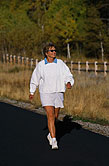- Skip Storing This Everyday Product in the Fridge Door
- Green Tea + B3 Pairing May Boost Brain Health
- Navigating Your Midlife Crisis: Embracing New Possibilities
- City Raccoons Showing Signs of Domestication
- Mapping the Exposome: Science Broadens Focus to Environmental Disease Triggers
- One Week Less on Social Media Linked to Better Mental Health
- Your Brain Changes in Stages as You Age, Study Finds
- Some Suicide Victims Show No Typical Warning Signs, Study Finds
- ByHeart Formula Faces Lawsuits After Babies Sickened With Botulism
- Switch to Vegan Diet Could Cut Your Greenhouse Gas Emissions in Half
Moderate Exercise May Cut Women’s Stroke Risk


Brisk walking, tennis and other types of moderate exercise may lower a woman’s stroke risk by one-fifth, a new study says.
Being more active also offset the increased stroke risk linked with using hormone replacement therapy to treat the symptoms of menopause, the study found.
The researchers looked at the number of strokes that occurred among nearly 133,500 women in the California Teachers Study, which ran from 1996 to 2010.
Women who said they did moderate physical activity in the three years before enrolling in the study were 20 percent less likely to have a stroke than those who were inactive. The findings were to be presented Thursday at the American Stroke Association’s International Stroke Conference in San Diego.
“I was surprised that moderate physical activity was most strongly associated with a reduced risk of stroke,” study author Sophia Wang, a professor in the department of population sciences in the Beckman Research Institute at the City of Hope in Duarte, Calif., said in a stroke association news release.
“More strenuous activity, such as running, didn’t further reduce women’s stroke risk. Moderate activity, such as brisk walking, appeared to be ideal in this scenario,” she added.
The researchers also found that postmenopausal women taking hormone therapy were 30 percent more likely to have a stroke than those who never used hormone therapy, but moderate exercise helped reduce this increased risk. And after women stopped taking hormone therapy, their risk began to fall.
The findings show that women need to include physical activity into their daily routine, Wang said.
“You don’t have to do an extreme boot camp. The types of activities we’re talking about are accessible to most of the population,” and include power walking and recreational tennis, she noted.
While 87 percent of the women in the study were white, the results likely apply to women in other racial/ethnic groups, Wang added.
Research presented at medical meetings should be viewed as preliminary until published in a peer-reviewed journal.
And the study only found an association between exercise and reduced stroke risk. It did not prove cause-and-effect.
More information
The U.S. Centers for Disease Control and Prevention has more about stroke prevention.
Source: HealthDay
Copyright © 2025 HealthDay. All rights reserved.










